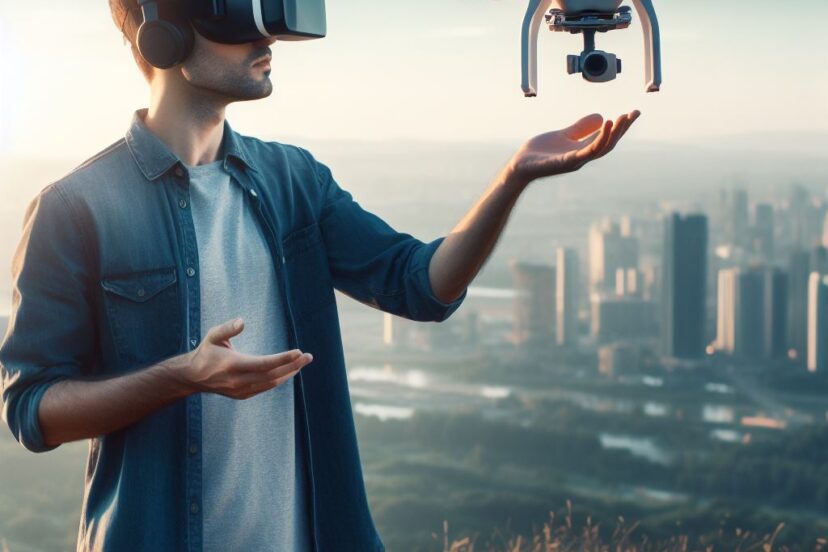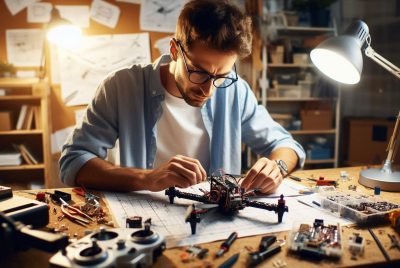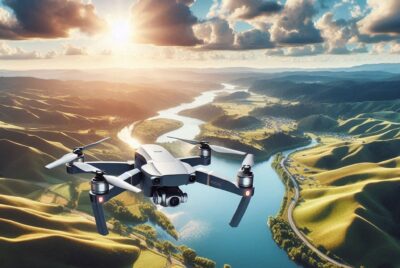VR Drone Technology: A Window to Aerial Immersion
*We may earn a commission for purchases made using our links. Please see our disclosure to learn more.
VR Drone Technology: Enhancing Aerial Photography and Immersive Experiences
Virtual reality (VR) has revolutionized the way I experience aerial footage and piloting. VR drones are essentially unmanned aerial vehicles (UAVs) that are paired with VR technologies, allowing me to immerse myself in a first-person view (FPV) of the drone’s flight. This means that when operating a VR drone, I can see what the drone sees as if I were on board, delivering a unique and thrilling perspective from the skies.
The technology behind these drones has come a long way in recent years. Modern VR drones, such as the DJI FPV Combo, are now bundled with advanced VR headsets and offer high-definition camera capabilities, like 4K 60-FPS video recording. This provides me with high-quality footage and real-time transmission that makes the flying experience incredibly vivid and engaging.
Using a VR drone, the controls become intuitive as I am effectively in the cockpit, piloting with a heightened sense of direction and depth. This is not just an enthralling hobby but a tool that opens up new possibilities in cinematography, inspection, mapping, and more. It’s essential, however, to follow safety guidelines and regulations when flying VR drones to ensure a safe flight experience for myself and others around me.
Understanding VR Drones

Virtual Reality (VR) drones are a revolutionary merge of standard drone technology with immersive VR capabilities. I’ll shed light on VR drones and how they provide an exhilarating First-Person View (FPV) experience.
First-Person View (FPV): FPV technology in drones allows me to experience flight from the drone’s perspective. When I wear a VR headset connected to the drone, the headset displays what the drone’s camera sees in real-time.
Capabilities of VR Drones:
- Immersive Experience: VR drones provide a truly immersive experience, making me feel as if I’m flying.
- VR Headsets: These are the key to viewing the drone’s camera feed, often offering high definition visuals.
- Flight Control: Advanced drones come with motion controllers to make the experience intuitive.
Standard Features I’ve Noticed in Quality VR Drones:
- Camera Quality: Usually, a 720p camera or higher ensures clear video quality.
- Flight Time: Ranges from 12 to 20 minutes, allowing for a meaningful time in the air.
- Flight Range: From 100 meters to several miles, depending on the drone model.
- Image Stabilization: Technologies like Electronic Image Stabilization (EIS) reduce video shakiness.
Safety: Safety is paramount in VR drone flights. Modern drones are equipped with obstacle avoidance systems and hover stability features, ensuring secure flights while I’m immersed in the VR experience.
By using VR drones, my perspective of aerial photography and flight has changed drastically. The fusion of VR headsets and FPV technology in drones brings remarkable experiences right before my eyes.
Key Features of VR Drones

When discussing the key features of VR drones, I focus on elements that affect the flying experience and imaging capabilities, as well as the drone’s design and handling.
Camera and Video Capabilities
The heart of a VR drone’s appeal lies in its camera technology, notably the ability to capture 4K video. High-resolution image capturing usually comes with a Hasselblad L1D-20c camera or something similar, featuring an advanced CMOS sensor. For an immersive flying experience, the camera quality is crucial, as it directly influences the clarity and detail of the VR content.
Flight Performance
A drone’s performance in flight is defined by its flight time and range. Typically, a high-quality VR drone will offer a flight time upwards of 30 minutes and a significant operating range, which can exceed 8 km. The obstacle avoidance system, often with multiple obstacle avoidance sensors, ensures the safety of the drone during flight by maintaining altitude and avoiding collisions, while HD video transmission keeps latency low for a real-time flying view.
Design and Build
VR drones are often built with a compact and lightweight, yet sturdy, design. Their portable design is a considerable advantage for pilots on the go. High-grade materials are used to enhance durability without compromising the drone’s ability to navigate with agility.
Control and Responsiveness
To match the high demands of VR flying, these drones are paired with responsive remote controls or motion controllers. They have features like head tracking that translates the pilot’s head movements into drone actions. Control systems offer various modes, from full manual to more simplified controls, allowing for both novice and experienced pilots to have an enjoyable experience. Finally, the low-latency transmission guarantees a connection that keeps up with the drone’s movements, making the responsiveness a key factor in a truly immersive flying experience.
Selecting VR Drones

When choosing a VR drone, it’s essential to consider the drone’s intended use, your budget constraints, and the type of VR headset that will offer the most immersive experience. I’ll guide you through the key factors to ensure compatibility and comfort for the best virtual reality experience with drones.
Drone Types by Use Case
For drone racing and fast-paced action, I recommend racing drones such as the DJI FPV, which is designed for high-speed performance and agility. For those interested in aerial photography, the DJI Mavic 2 Pro with its high-resolution camera serves well. Hobbyists might enjoy drones with VR headsets like the DJI Tello for a budget-friendly introduction to VR flying.
Budget-Conscious Options
When your budget is a primary concern, there are budget-friendly options available that do not compromise on the VR experience. The DJI Tello is a great start for those wanting to explore drone flying with phone VR headsets. For a slightly higher price, the DJI Goggles paired with a DJI drone can provide an immersive FPV experience without breaking the bank.
High-End VR Drone Models
If budget is less of a constraint, the DJI Avata stands out for its combination of compact design and exceptional FPV goggles. On the higher end, the Autel Robotics EVO II offers robust camera capabilities along with a VR experience when paired with specialized VR headsets.
Comparing VR Headsets
When matching a VR headset to your drone, compatibility is key. DJI’s FPV Goggles V2 and Goggles 2 are highly compatible with their drones, offering an out-of-the-box solution. For a standalone VR experience, the Oculus Quest 2 can be a great choice, though it might not integrate as seamlessly with your drone as DJI’s dedicated options.
In summary, matching the drone to its use case, staying within budget, opting for high-quality models, and selecting compatible VR headsets are all steps that will lead to a thrilling and comfortable VR flying experience.
Drone and VR Technology

The integration of VR technology with drones has revolutionized the way I experience flight, allowing me to be virtually inside the cockpit for an immersive flying experience. Let’s explore the current state of VR drone tech, its applications in FPV systems, and the advancements in camera technology that enrich this experience.
Innovations in VR Drone Tech
In recent years, VR goggles have become more than just an accessory; they’re a gateway to experiencing flight like never before. Innovations such as Augmented Reality (AR) overlays provide me with real-time flight data, adding a layer of information to my flight sessions. Drones like the Parrot Bebop 2 FPV and the DJI Mavic Mini have embraced these advancements, allowing for features like 8D flips that are experienced in an entirely new way through VR.
Understanding FPV Systems
First Person View (FPV) systems fundamentally change my flying experience by streaming live video from the drone to VR goggles or headsets like the DJI Goggles or Parrot Cockpitglasses. My control is more intuitive with devices like the SkyController and SkyController 2, which facilitate a seamless connection between the drone and my VR equipment. The intuitive DJI RC Motion 2 controller with the Mavic Air 2 provides me with a remarkably responsive flying experience, enhancing my sense of presence.
Advancements in Camera Technology
The camera technology in drones has seen significant improvements, particularly with the CMOS sensor. High-resolution 4K cameras on drones such as the DJI Mini 3 Pro and the Yuneec Typhoon H capture extraordinary detail, and when paired with a VR headset, offer an unbeatable immersive experience. The ability to use a Micro SD card to store footage and the inclusion of advanced stabilization have also improved the quality of footage I can capture, even in high-motion scenarios.
Practical Tips for VR Drone Users

I’ve found that maximizing the flight experience, considering safety and maintenance, and enhancing VR interactivity are vital for getting the most out of VR drones. Let’s explore some specific tips in these areas.
Maximizing Flight Experience
When it comes to flying a drone with a VR headset, achieving a vibrant and responsive experience requires attention to both hardware and settings. I recommend opting for drones that support 4K video at 60 fps to ensure you’re capturing crisp, smooth footage. It’s essential to personalize flight options, toggling between manual mode for complete control and EZ Shots for pre-programmed cinematic sequences. Moreover, for an immersive experience, drones equipped with head tracking add a layer of interactivity; they change camera angles based on your head movements, making for an intuitive flight session.
Key Tips:
- Use drones with 4K video and 60 fps capability for quality visuals.
- Personalize flight settings: Manual mode for control, EZ Shots for automated captures.
Safety and Maintenance
When it comes to maintenance and safety of VR drones, I prioritize regular check-ups and awareness of the device’s safety features. For instance, obstacle avoidance systems can prevent collisions by providing real-time data and responsive controls to navigate around potential hazards. It’s also crucial that you ensure a clear line of sight with the drone during operations and to respect local regulations to maintain not only the safety of your equipment but also of those around you.
Pre-Flight Checklist:
| Check | Description |
| Battery Life | Ensure full charge before take-off. |
| Obstacle Avoidance | Confirm sensors are functional. |
| Firmware | Keep drone’s software up to date. |
| Local Laws | Review and comply with regional drone regulations. |
Enhancing VR Interactivity
To increase the immersive nature of drone flights with a VR headset, I apply technology like motion controllers that allow me to navigate the drone with natural hand movements. This not only enhances the control but also adds to the realism of the VR flying experience. Drones with head tracking are preferable, as they provide seamless coordination between your vision and the drone’s camera, creating a truly immersive experience.
Interaction Boosters:
- Motion Controller: Use for intuitive, gesture-based navigation.
- Head Tracking: Sync your head movements with the drone’s camera for an enhanced visual experience.
Remember, an enriched VR drone experience comes from the synergy of high-fidelity visuals, sound safety practices, and effective interactivity options.
Frequently Asked Questions
1. What features should I look for in a VR-compatible drone?
I recommend seeking drones with high-quality cameras and stable video transmission for a compelling VR experience. Features like a 720p camera, electronic image stabilization (EIS), and a reliable flight time (around 12 minutes or more) are essential. Furthermore, a control range of at least 100 meters is ideal for a safe VR flying experience.
2. How does the VR experience enhance drone flying?
VR headsets provide an immersive first-person view (FPV), putting me in the cockpit of the drone. This real-time perspective significantly enriches the flying experience, making it more intuitive and engaging, especially for aerial photography and exploration.
3. What is the price range for competitive VR drones on the market?
Competitive VR drones vary in price from around $300 for basic models up to several thousand dollars for professional-grade equipment. The price escalates with advancements in camera technology, flight capabilities, and additional features.
4. Can VR headsets be used with any drone model?
No, not all drones are compatible with VR headsets. VR functionality requires a drone with FPV capability, which means it must transmit live video to a device that can integrate with VR headsets. Compatibility is something you need to confirm before purchase.
5. How do VR drone applications improve the piloting experience?
VR drone applications offer improved situational awareness, with a heads-up display of flight data and enhanced control interface. It allows me to fly the drone more precisely, making maneuvers and photography that much more enjoyable and accurate.




